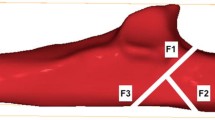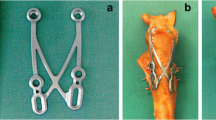Abstract
Introduction
The gold standard for treating transverse olecranon fractures is tension band fixation. A problem with this technique is migration of the K-wires leading to premature hardware removal. The aim of this study is to compare stability provided by two new techniques designed to eliminate the problem with backing out of K-wires, with that of the recommended tension band technique, performed with a biomechanical in vitro investigation. Our hypothesis was that the two new techniques would provide at least equal stability as the traditional tension band fixation.
Methods
Transverse olecranon osteotomies were created in human cadaveric elbows to simulate a type 21-B1.1 fracture. Three groups of 8 specimens were instrumented with: (1) recommended AO tension band technique; (2) modified K-wires with eyelets and tension band; (3) staples across the fracture with tension band. Each elbow was tested in a 90° flexed position. The triceps tendon was sinusoidally loaded by applying two load steps at 500 and 700 N for 4000 cycles each. Relative movements between the fragments were determined.
Results
At the end of the first and second load step the displacement of the osteotomy at the posterior ulnar side was significantly less for the staples across the fracture with tension band as compared to both other groups. There were no significant differences between groups 1 and 2.
Conclusion
Since clinical results depend partly on stable fixation, it is concluded that using staples in the clinical situation might provide better results than the currently recommended tension band technique.





Similar content being viewed by others
References
Chalidis BE, Sachinis NC, Samoladas EP, Dimitriou CG, Pournaras JD (2008) Is tension band wiring technique the “gold standard” for the treatment of olecranon fractures? A long term functional outcome study. J Orthop Surg 3:9
Gartsman GM, Sculco TP, Otis JC (1981) Operative treatment of olecranon fractures. Excision or open reduction with internal fixation. J Bone Jt Surg Am 63:718–721
Weber BG, Vasey H (1963) Osteosynthesis in olecranon fractures. Z Unfallmed Berufskr 56:90–96
Molloy S, Jasper LE, Elliott DS, Brumback RJ, Belkoff SM (2004) Biomechanical evaluation of intramedullary nail versus tension band fixation for transverse olecranon fractures. J Orthop Trauma 18:170–174
Mullett JH, Shannon F, Noel J, Lawlor G, Lee TC, O’Rourke SK (2000) K-wire position in tension band wiring of the olecranon—a comparison of two techniques. Injury 31:427–431
Doursounian L, Prevot O, Touzard RC (1994) Osteosynthesis by tension band wiring of displaced fractures of the olecranon. Ann Chir 48:169–177
Jensen CM, Olsen BB (1986) Drawbacks of traction-absorbing wiring (TAW) in displaced fractures of the olecranon. Injury 17:174–175
Macko D, Szabo RM (1985) Complications of tension-band wiring of olecranon fractures. J Bone Jt Surg Am 67:1396–1401
Romero JM, Miran A, Jensen CH (2000) Complications and re-operation rate after tension-band wiring of olecranon fractures. J Orthop Sci 5:318–320
Quintero J, Varecka T (2007) Olecranon, radial head, and complex elbow injuries. In: Ruedi TP, Buckley RE, Moran CG (eds) AO principles of fracture management, volume 2, specific fractures, 2nd edn. AO Publishing–Thieme, Stuttgart, pp 626–695
Prayson MJ, Williams JL, Marshall MP, Scilaris TA, Lingenfelter EJ (1997) Biomechanical comparison of fixation methods in transverse olecranon fractures: a cadaveric study. J Orthop Trauma 11:565–572
Prayson MJ, Iossi MF, Buchalter D, Vogt M, Towers J (2008) Safe zone for anterior cortical perforation of the ulna during tension-band wire fixation: a magnetic resonance imaging analysis. J Shoulder Elbow Surg 17:121–125
Candal-Couto JJ, Williams JR, Sanderson PL (2005) Impaired forearm rotation after tension-band-wiring fixation of olecranon fractures: evaluation of the transcortical K-wire technique. J Orthop Trauma 19:480–482
Matthews F, Trentz O, Jacob AL, Kikinis R, Jupiter JB, Messmer P (2007) Protrusion of hardware impairs forearm rotation after olecranon fixation. A report of two cases. J Bone Jt Surg Am 89:638–642
Netz P, Stromberg L (1982) Non-sliding pins in traction absorbing wiring of fractures: a modified technique. Acta Orthop Scand 53:355–360
Hak DJ, Golladay GJ (2000) Olecranon fractures: treatment options. J Am Acad Orthop Surg 8:266–275
Kozin SH, Berglund LJ, Cooney WP, Morrey BF, An KN (1996) Biomechanical analysis of tension band fixation for olecranon fracture treatment. J Shoulder Elbow Surg 5:442–448
Paremain GP, Novak VP, Jinnah RH, Belkoff SM (1997) Biomechanical evaluation of tension band placement for the repair of olecranon fractures. Clin Orthop Relat Res 325–330
Dieterich J, Kummer FJ, Ceder L (2006) The olecranon sled—a new device for fixation of fractures of the olecranon: a mechanical comparison of two fixation methods in cadaver elbows. Acta Orthop 77:440–444
Karlsson MK, Hasserius R, Besjakov J, Karlsson C, Josefsson PO (2002) Comparison of tension-band and figure-of-eight wiring techniques for treatment of olecranon fractures. J Shoulder Elbow Surg 11:377–382
Larsen E, Lyndrup P (1987) Netz or Kirschner pins in the treatment of olecranon fractures? J Trauma 27:664–666
Rowland SA, Burkhart SS (1992) Tension band wiring of olecranon fractures. A modification of the AO technique. Clin Orthop Relat Res (277)238–242
Carpenter JE, Kasman RA, Patel N, Lee ML, Goldstein SA (1997) Biomechanical evaluation of current patella fracture fixation techniques. J Orthop Trauma 11:351–356
Hutchinson DT, Horwitz DS, Ha G, Thomas CW, Bachus KN (2003) Cyclic loading of olecranon fracture fixation constructs. J Bone Jt Surg Am 85-A:831–837
Parent S, Wedemeyer M, Mahar AT, Anderson M, Faro F, Steinman S, Lalonde F, Newton P (2008) Displaced olecranon fractures in children: a biomechanical analysis of fixation methods. J Pediatr Orthop 28:147–151
Fyfe IS, Mossad MM, Holdsworth BJ (1985) Methods of fixation of olecranon fractures. An experimental mechanical study. J Bone Jt Surg Br 67:367–372
King GJ, Lammens PN, Milne AD, Roth JH, Johnson JA (1996) Plate fixation of comminuted olecranon fractures: an in vitro biomechanical study. J Shoulder Elbow Surg 5:437–441
Moed BR, Ede DE, Brown TD (2002) Fractures of the olecranon: an in vitro study of elbow joint stresses after tension-band wire fixation versus proximal fracture fragment excision. J Trauma 53:1088–1093
Murphy DF, Greene WB, Gilbert JA, Dameron TB, Jr. (1987) Displaced olecranon fractures in adults. Biomechanical analysis of fixation methods. Clin Orthop Relat Res (224)210–214
Nowak TE, Mueller LP, Burkhart KJ, Sternstein W, Reuter M, Rommens PM (2007) Dynamic biomechanical analysis of different olecranon fracture fixation devices—tension band wiring versus two intramedullary nail systems: an in vitro cadaveric study. Clin Biomech (Bristol, Avon) 22:658–664
Petraco DM, Koval KJ, Kummer FJ, Zuckerman JD (1996) Fixation stability of olecranon osteotomies. Clin Orthop Relat Res (333)181–185
Larsen E, Jensen CM (1991) Tension-band wiring of olecranon fractures with nonsliding pins. Report of 20 cases. Acta Orthop Scand 62:360–362
Kinik H, Us AK, Mergen E (1999) Self-locking tension band technique. A new perspective in tension band wiring. Arch Orthop Trauma Surg 119:432–434
Malal JJ, Hegde G, Ferdinand RD (2006) Tarsal joint fusion using memory compression staples—a study of 10 cases. J Foot Ankle Surg 45:113–117
Mereau TM, Ford TC (2006) Nitinol compression staples for bone fixation in foot surgery. J Am Podiatr Med Assoc 96:102–106
Musialek J, Filip P, Nieslanik J (1998) Titanium–nickel shape memory clamps in small bone surgery. Arch Orthop Trauma Surg 117:341–344
Acknowledgments
The authors wish to thank Synthes Inc. for the provision of the implants and instruments.
Conflict of interest
The authors have an affiliation with the AO Foundation which is partly funded by non-directed and unrestricted royalties from licenses granted to Synthes Inc. The authors are not compensated and there are no other institutional subsidy, corporate affiliations, or funding sources supporting this work.
Author information
Authors and Affiliations
Corresponding author
Rights and permissions
About this article
Cite this article
Sadri, H., Stern, R., Singh, M. et al. Transverse fractures of the olecranon: a biomechanical comparison of three fixation techniques. Arch Orthop Trauma Surg 131, 131–138 (2011). https://doi.org/10.1007/s00402-010-1156-6
Received:
Published:
Issue Date:
DOI: https://doi.org/10.1007/s00402-010-1156-6




